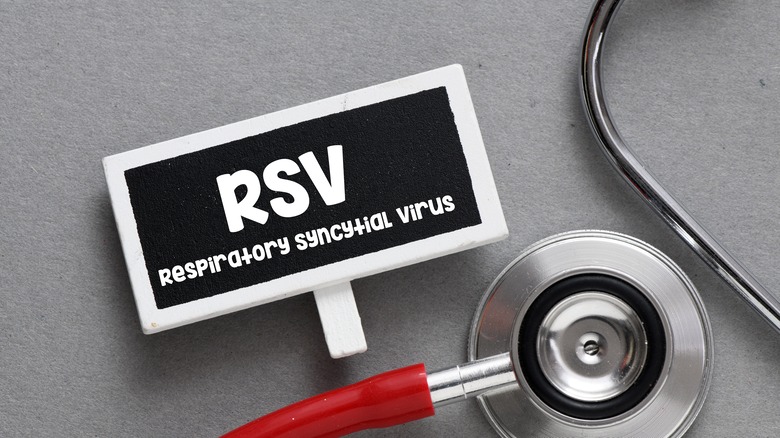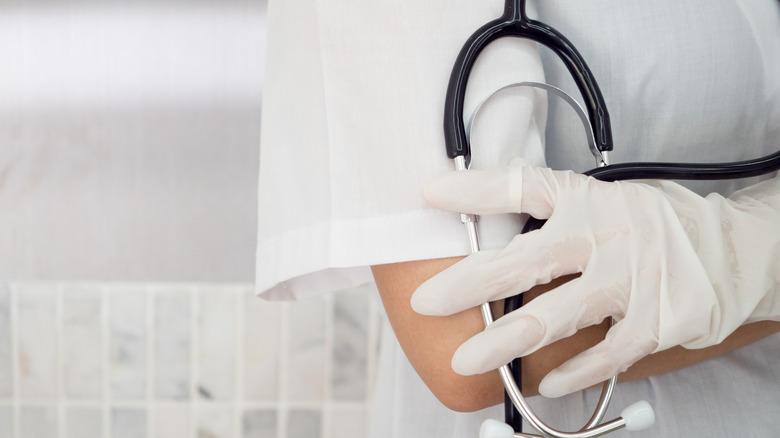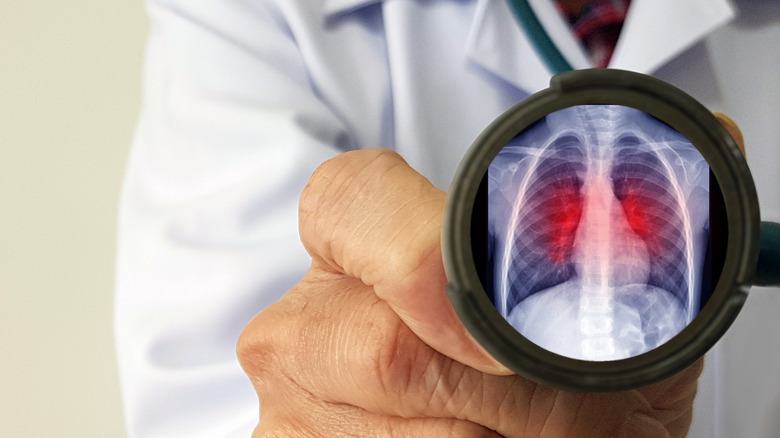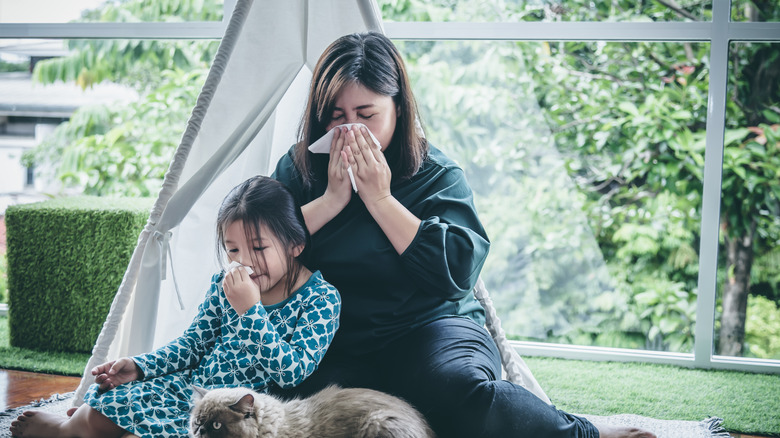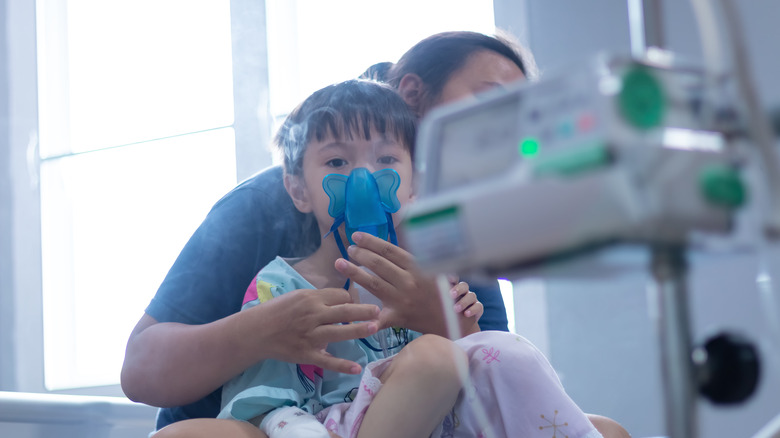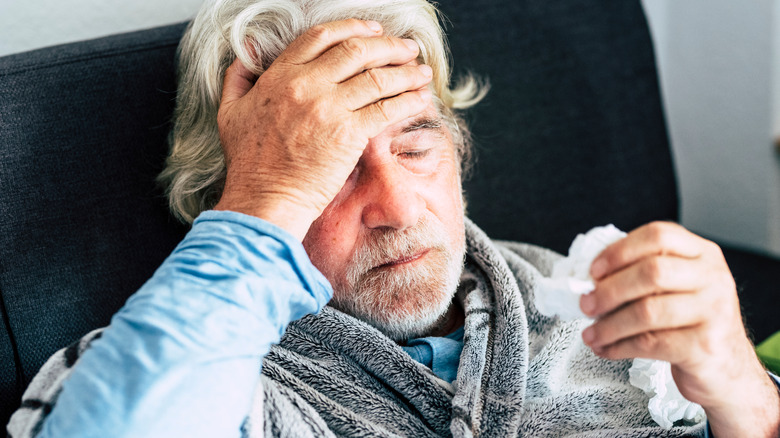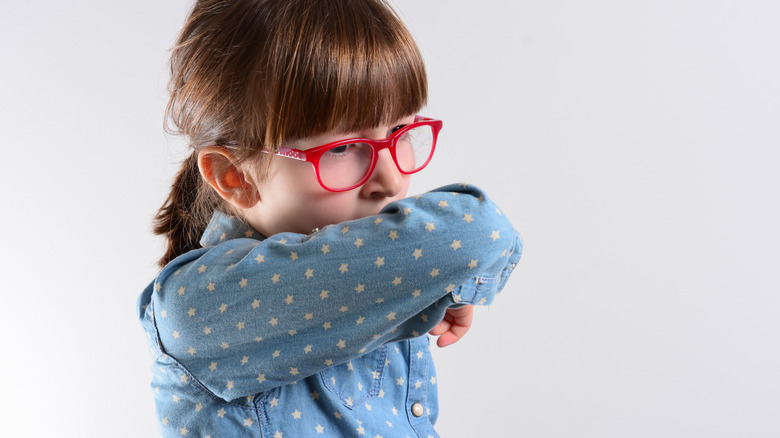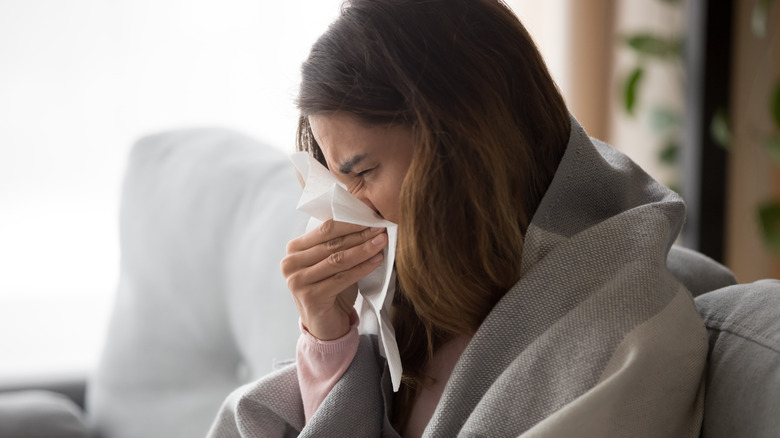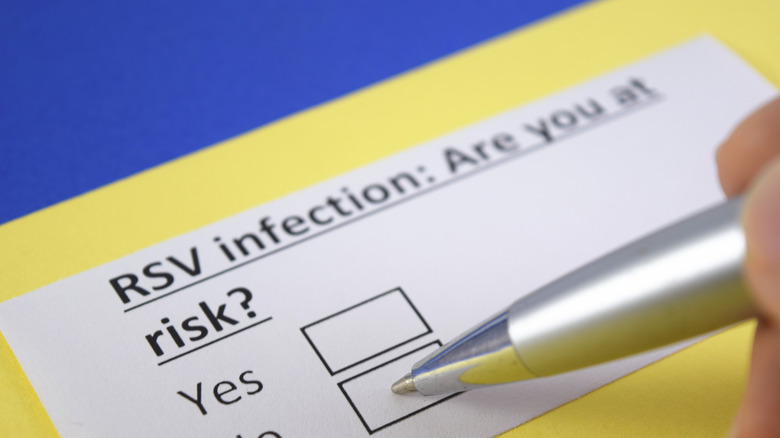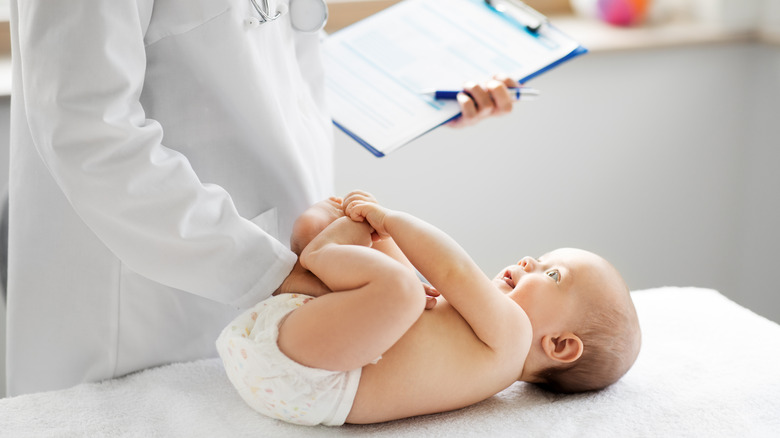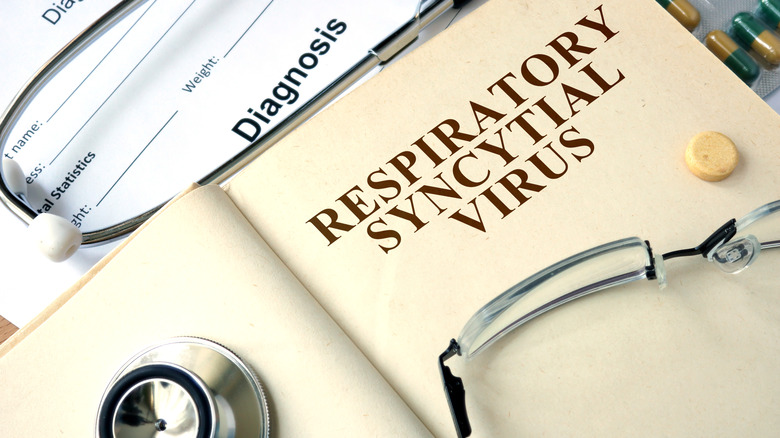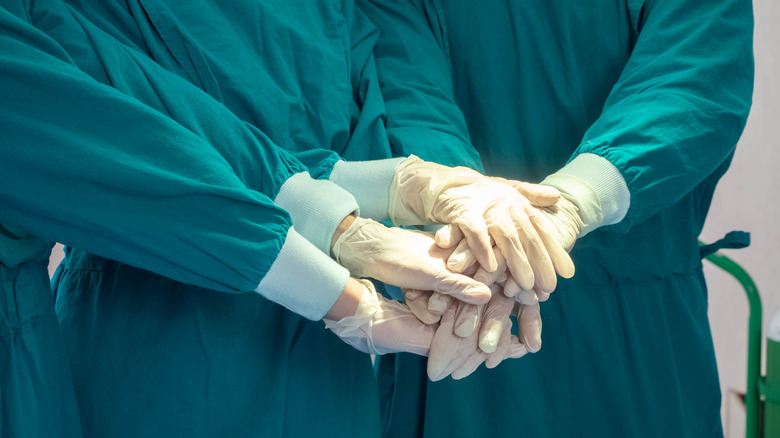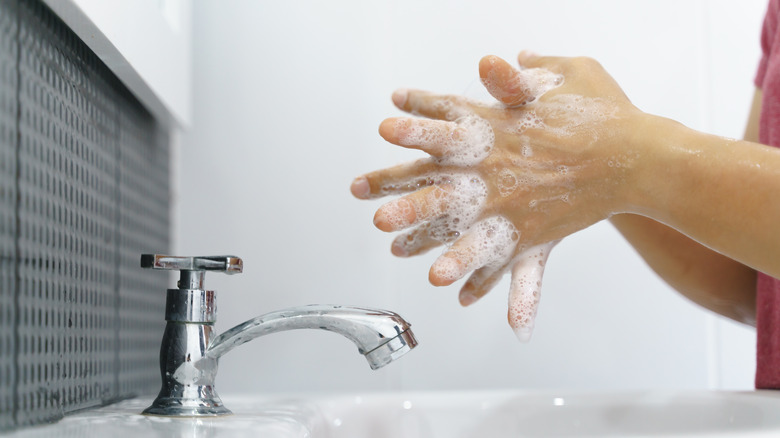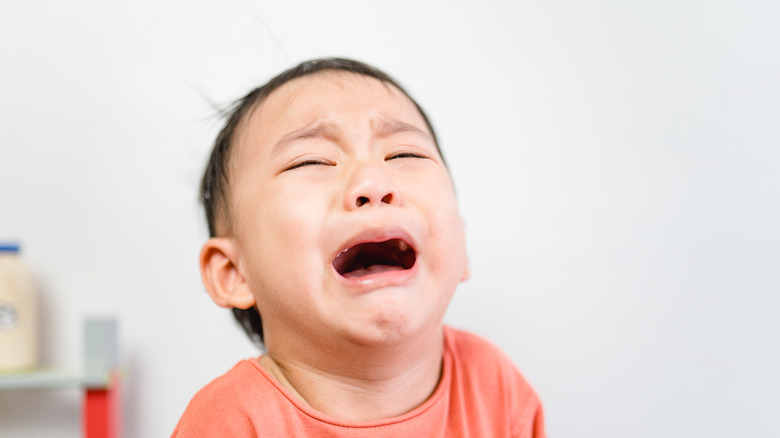RSV Explained: Causes, Symptoms, And Treatments
If you have young children in a school setting, you likely have heard of this respiratory virus. Respiratory syncytial virus, or RSV, is a highly contagious seasonal virus that infects the lungs and causes mild cold-like symptoms (via the Centers for Disease Control and Prevention).
RSV typically spreads from the fall to the spring, and has become very common since its discovery in 1956. In fact, all children will likely have had RSV by their second birthday, according to the CDC. RSV sends 2.1 million children under 5 years old to the doctor for outpatient care each year and is the cause of 58,000 hospitalizations.
But it's not just children that are at risk of RSV. Adults can also contract RSV, and it can be especially problematic for those with weakened immune systems or the elderly (via American Lung Association).
Since RSV is so contagious, it is important to know the symptoms to look out for, as well as the treatment and preventative measures you can take to keep yourself and your family healthy. You should also be aware of risk factors and when it is time to go see a doctor about your RSV case.
What is RSV?
First off, let's dive into what exactly RSV is. RSV affects the lungs and the smaller passageways called bronchioles that carry air to the lungs (via Cleveland Clinic). RSV can be a starting point to other respiratory complaints.
RSV can be as mild as a cold, but can increase in severity depending on your personal health and the strain of the virus. There are A and B strains of RSV, according to the CHEST Foundation.
For children, RSV is the most common cause of bronchiolitis — inflammation of the bronchioles — and pneumonia (via Centers for Disease Control and Prevention). For many, RSV starts as an upper respiratory tract infection, or a cold, and moves into the lower respiratory tract, causing bronchiolitis.
In bronchiolitis, the inner linings of the bronchi and bronchioles swell, clogging up your breathing tubes with destroyed cells and mucus (via CHEST Foundation). This inflammation also causes the muscles around your airways to tighten and make breathing harder.
What causes RSV
RSV enters your body through the eyes, mouth, or nose, due to it spreading through the air via respiratory droplets or fluids (via Mayo Clinic). This means coughs and sneezes are major causes of RSV, as well as direct contact with someone who is infected.
RSV can even be caused if you touch a contaminated surface or item, then touch your own eyes, mouth, or nose. The virus can survive on surfaces like tables, clothing, toys, or hands for hours (via Medical News Today). This could explain why people with children in daycare or school are more prone to being exposed to RSV.
So when can you expect to start feeling the effects of RSV? Typically, RSV symptoms become apparent between 2-8 days from the time of exposure (via American Lung Association). You can expect to feel sick for up to a week, but exact timing can vary. You are also the most contagious during this period, so try to avoid being in close contact with others, to prevent spread.
Symptoms of RSV
So here's what you should look out for in an RSV infection. Coughing, a decrease in appetite, fever of 100.4 degrees Fahrenheit or higher, mild headache, runny nose or congestion, sneezing, and wheezing are some common symptoms that you may see in stages — not all at once (via Centers for Disease Control and Prevention). Young infants may not even experience all of these symptoms that are similar to a mild cold. Instead, they might be fatigued, have breathing difficulties, have poor feedings, or just be more irritable than usual.
You will want to be cognizant of any barking or wheezing coughs, as these can be symptoms of a more serious condition. According to the American Academy of Pediatrics, when RSV develops into the lower respiratory tract, there can be additional breathing-related symptoms for children, that include fast breathing, nostril-flaring, or head-bobbing with breathing. You may also hear more grunting during breathing.
Symptoms are usually the worst in days 3-5 of RSV, so hopefully after day 5 you are on your way to recovery.
Risk factors for RSV
Like with many illnesses, there are populations who are at an additional risk for RSV or more serious complications. RSV can even be life-threatening for premature infants, children with congenital or lung disease, and those with weakened immune systems (via American Lung Association). Children who have neuromuscular disorders, specifically ones who have issues swallowing or clearing mucus, have more of a chance of a more-severe case of RSV.
People of all ages with immunodeficiencies, like chemotherapy patients, those with HIV or AIDS, and organ transplant recipients, are at a higher risk. The risk factors extend to the older population, specifically those with heart or lung disease like asthma, congestive heart failure, or chronic obstructive pulmonary disease (COPD).
The American Academy of Pediatrics also lists additional risk factors for children, including low birth weights, maternal smoking during pregnancy or exposure to secondhand smoke in their home, not being breastfed, or having a history of allergies or eczema. As mentioned before, having siblings or exposure to crowded living conditions can also lead to a higher chance of RSV infections.
RSV in infants
RSV is a common ailment for infants, and they usually show symptoms or signs of infection, according to the Centers for Disease Control and Prevention.
"When you look at the number one cause of hospitalization in the first year of life, the number one is RSV," Dr. Octavio Ramilo, chief of infectious diseases at Nationwide Children's Hospital in Columbus, Ohio, told LiveScience.
RSV can be more severe for infants. You should look for signs of breathing issues, including the "caving-in" of the chest in between the ribs and under the ribs, as well as their mouth, lips and fingernails turning blue due to lack of oxygen (via American Lung Association). Dehydration is also a concern for infants, so if your child has less than one wet diaper every eight hours, the American Academy of Pediatrics recommends contacting your healthcare provider.
Contracting RSV as a baby may also lead to childhood asthma later in life, according to Cedars-Sinai.
RSV in adults
Adults over the age of 65 can also experience severe reactions to RSV. The Centers for Disease Control and Prevention estimates that each year more than 177,000 older adults are hospitalized, with 14,000 dying due to RSV.
When most adults get RSV, it is like a mild cold. However, there is a chance for more serious cases that result in pneumonia, congestive heart failure, and severe symptoms for people with asthma or chronic obstructive pulmonary disease.
You may be wondering why older adults have more of a chance to have severe cases of RSV than younger adults. Older adults can experience more complications due to RSV because of how our immune systems weaken as we get older (via the CDC).
On the other hand, many older children and adults may not experience RSV symptoms at all, according to the Cleveland Clinic. These cases can be more like mild cold symptoms, however, you may inadvertently be spreading RSV by thinking you just have a cold.
Transmitting RSV
As you probably have gathered by now, RSV is highly contagious. The transmission can occur with both direct and indirect contact with an infected person. Coughing and sneezing that results in virus droplets in your eyes, nose, or mouth, as well as direct contact like kissing the face of an infected person, are possible ways to contract RSV (via Centers for Disease Control and Prevention).
You can also get RSV from touching a surface with the virus on it and then touching your face. RSV survives on soft surfaces like cloth or hands for a shorter time than harder surfaces like tables or crib rails, according to the CDC. Transmission commonly occurs in a public place like a daycare or school, with the infected person then spreading the virus to the rest of their family.
While you typically are only contagious for up to eight days, some people can spread the virus without symptoms for a month after infection. This is more likely for infants and immunocompromised people.
RSV vs COVID-19
In the era of COVID-19 and other flu-related illnesses, it can be tough to determine whether you are suffering from a cold or something more serious. While the symptoms are similar between RSV and COVID-19, there are some stark differences between the two.
"In addition to the common fever and cough symptoms, there are some differentiating symptoms. For example, we know that COVID-19 often presents with unique symptoms, such as loss of taste and smell, fatigue and muscle aches. This is not so common with RSV," pediatric infectious disease specialist Dr. Priya Soni tells Cedars-Sinai.
Adults may also experience more severe symptoms if they are suffering from COVID-19, like difficulty breathing, while children may only experience mild cold-like symptoms. Additionally, if you already have RSV, your immunity levels may be low enough to increase the risk of getting COVID-19.
Soni adds that you should check to see if RSV is circulating in your area before fearing COVID-19. There is also a rare possibility that you could have both RSV and COVID-19. Luckily, there is testing for both COVID-19 and RSV — but more on that later!
Complications of RSV
RSV can lead to some serious complications for both the children and adult populations. Premature babies, infants under one years old, and kids with heart, immune system, or lung diseases can experience bronchiolitis or pneumonia as a result of an RSV case (via Nemours Kids Health). According to the American Lung Association, 25-40% of this high-risk group develop these complications and up to 20% of infant RSV cases require hospitalization.
Dehydration is also a concern for children with RSV. This complication may lead to a hospital visit for administration of fluids and closer monitoring for other issues, according to Nemours Kids Health.
Adults over 65 years old, especially immunocompromised adults, may experience similar complications of pneumonia and bronchiolitis. They may also have longer recovery times from RSV (via Kaiser Permanente). Severe RSV cases can cause respiratory failure for adults, so it is important to monitor symptoms and seek additional medical attention if they worsen.
Diagnosing RSV
So if you suspect you or a loved one has RSV, how do you go about having it diagnosed? The first step will likely be a physical exam from your doctor, with a focus on your lungs (via Mayo Clinic). A diagnosis may be made based on the time of year and your medical history.
While testing may not be necessary, there are several laboratory tests for RSV, with some testing being more sensitive than others. The real-time reverse transcriptase-polymerase chain reaction (rRT-PCR) is a more sensitive test than antigen testing, which is considered highly sensitive in detecting RSV in children but not adults (via Centers for Disease Control and Prevention). Some of these tests can determine whether you have the A or the B strain of RSV, but experts say it's not clear what the significance is between identifying which strain you have.
Other testing possibilities are blood tests to check white cell counts and check for other viruses; chest X-rays for inflamed lungs; mouth or nose swabs; or a pulse oximeter to check your oxygen level, according to the Mayo Clinic.
Treatment options for RSV
Now that you have an RSV diagnosis, it is time to weigh your treatment options. Most RSV cases go away on their own within a couple of weeks, but either way, there is no specific treatment for RSV, though vaccines and antiviral medications are in the works, according to the Centers for Disease Control and Prevention. Otherwise, experts recommend managing your pain and fever with over-the-counter medications like acetaminophen or ibuprofen for adults.
If your child has RSV, try to make your child as comfortable as you can at home, provide fluids, and treat a fever if needed with a non-aspirin fever medicine (via Nemours Kids Health). For a stuffy nose, you can use saline nose spray and a nasal aspirator if your child can't blow their nose. Avoid over-the-counter cold medications unless your doctor specifies to use one.
You will want to seek additional medical attention if it seems like your child is dehydrated, with symptoms like dry mouth, minimal urination, sunken eyes, and extreme fussiness or sleepiness (via Mayo Clinic). If hospitalization is needed, IV treatment for fluids, humidified oxygen, or a breathing machine are possible treatment options. Hospital stays typically only last a few days.
When to see a doctor
It's tough to see your child in pain. But how do you know when you should see a doctor? First off, it is important to note you should always ask your doctor any questions you may have about an illness, regardless of symptoms. It's always best to err on the side of caution when it comes to your health or your child's health.
Other signs that the RSV case may need additional care are a fever, worsening symptoms like coughing or wheezing, dehydration, and refusal to eat (via Nemours Kids Health). You should get help immediately if you or your child are experiencing difficulty breathing or fast breathing and extreme drowsiness.
The actual doctor's visit is a perfect time to get more information on RSV to set your mind at ease. Some questions to ask your doctor when seeking RSV treatment are if you or your child are at risk for severe RSV infections, if isolation is needed, treatment options and side effects, and if any testing is needed (via American Lung Association).
How you can prevent RSV
There isn't a cure for RSV, but it is preventable. Prevention is key, as you can be infected with RSV more than once in your life — and even a season (via Cleveland Clinic). The subsequent infections shouldn't be as bad as the first infection unless you are an older adult or are immunocompromised.
If you believe you may be infected with RSV, you should cover your coughs and sneezes with a tissue or shirt sleeve, wash your hands for at least 20 seconds, avoid close contact with others (especially high-risk children), and clean highly trafficked areas (via Centers for Disease Control and Prevention).
"The main thing parents can do is continue to be vigilant about hygiene for themselves and their children. That means encouraging hand-washing, especially after interacting with other children, and mask-wearing, when possible, particularly in indoor settings," pediatric infectious disease specialist Dr. Priya Soni tells Cedars-Sinai.
The CDC also recommends parents with high-risk children to do the usual prevention tactics, as well as avoiding contact with sick people or touching their face with unwashed hands, and limiting time in crowds or childcare centers during RSV season. There is also a prevention drug called palivizumab for certain high-risk children, according to Centers for Disease Control and Prevention. Palivizumab can help prevent serious RSV disease but does not cure or treat current RSV cases. You should talk with your medical team to see if this is an option for your child.
Dealing with RSV
Unfortunately, there is no cure for RSV currently. Several vaccines, monoclonal antibodies, and antiviral therapies are in the works to help children, pregnant women, and older adults from developing a severe RSV case (via Centers for Disease Control and Prevention).
In the meantime, dealing with RSV likely means you are trying to just keep yourself or your child comfortable while the illness runs its course. This can mean extra attention for your child, self-care, and extra rest.
"The treatment is supportive measures. That includes managing fever, (staying) hydrated, and in small babies, suctioning of the nasal secretions so they can breathe better is very important," pediatric infectious disease specialist Dr. Priya Soni tells Cedars-Sinai. "We also often encourage the use of a humidifier."
Other symptom-relieving tactics you can try at home are creating moisture in your air by keeping the room warm (but not too hot), using saline nasal drops, and staying away from cigarette smoke (via Mayo Clinic).
As always, contact your healthcare provider with any questions you have on symptoms or treatment for RSV.
